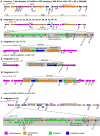Identification of Multiple Variant Extensively Drug-Resistant Typhoid Infections across Pakistan
- PMID: 36623485
- PMCID: PMC9896340
- DOI: 10.4269/ajtmh.22-0071
Identification of Multiple Variant Extensively Drug-Resistant Typhoid Infections across Pakistan
Abstract
Typhoid fever, caused by Salmonella enterica serovar Typhi (S. Typhi), is a life-threatening bacterial infection. Recently, an outbreak of a new sublineage of extensively drug resistant (XDR) S. Typhi emerged in Pakistan in the province of Sindh. This sublineage had both a composite multidrug resistance transposon integrated on the chromosome and an acquired IncY plasmid carrying the extended spectrum beta-lactamase, blaCTX-M-15, which conferred resistance to third-generation cephalosporins. We observed previously that XDR typhoid had spread beyond the originating southern Sindh Province. Thus, we sought to determine the genetic diversity of 58 ceftriaxone-resistant S. Typhi clinical isolates by whole genome sequencing collected across Pakistan from November 2018 to December 2020 to provide insights into the molecular epidemiology of the evolving outbreak. We identify multiple novel genomic integrations of the extended spectrum beta-lactamase gene into the chromosome in S. Typhi, revealing the existence of various XDR typhoid variants circulating in the country. Notably, the integration of the IncY plasmid bearing antibiotic resistance genes may allow for subsequent plasmid acquisition by these variants, potentially leading to further plasmid-borne multidrug resistance. Our results can inform containment initiatives, help track associated outcomes and international spread, and help determine how widespread the risk is.
Figures





References
-
- World Health Organization , 2018. 2018 - Pakistan. Available at: https://www.who.int/emergencies/disease-outbreak-news/item/27-december-2.... Accessed October 23, 2022.
MeSH terms
Substances
LinkOut - more resources
Full Text Sources

